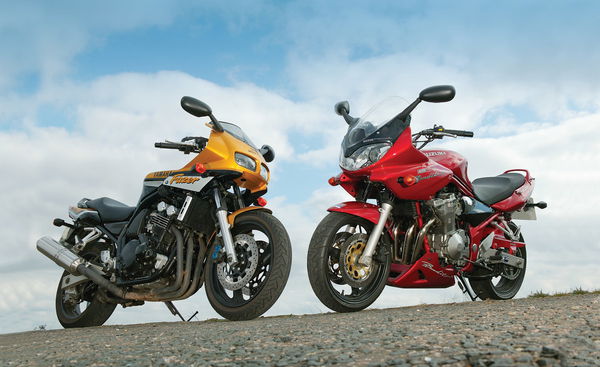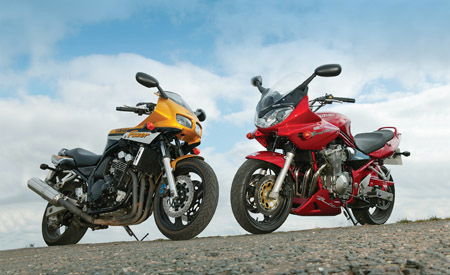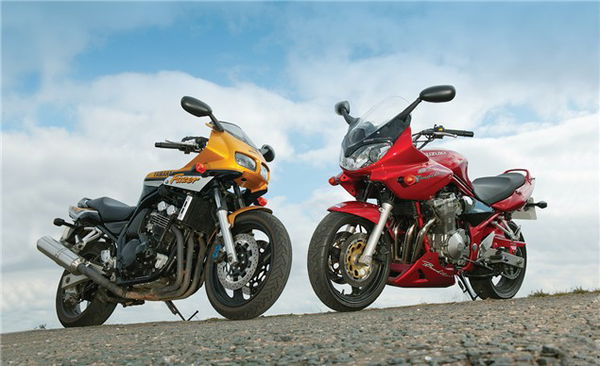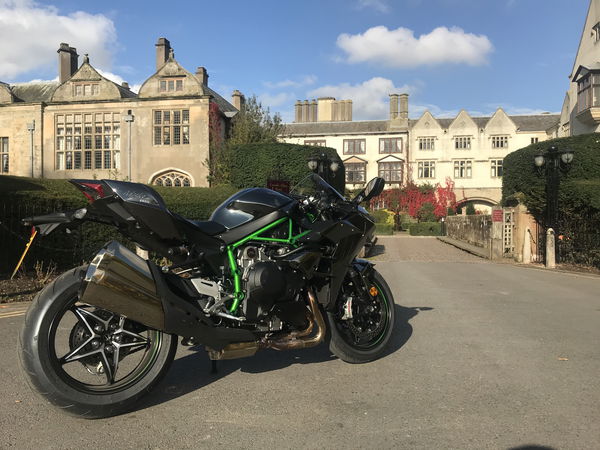Used Review: Yamaha Fazer V Suzuki Bandit
Two of the hardiest perennials in the middleweight category go head to head

 |
Yamaha started all the budget middleweight shenanigans way back in 1992.
It noticed a gap in the market, filled it with its utilitarian XJ600 Diversion and created the first budget middleweight. The 'Divvie', as it was soon nicknamed, was nothing to shout about. And though it became popular with despatchers, its slow, crude and basic nature kept most of us away.
Then Suzuki stepped in with its Bandit 600 and the budget class began in earnest. Back in 1995, the Bandit - essentially a parts-bin special - offered impressive enough performance and pretty cool looks to go with it. Not only was it a whole lot better than the Diversion, it was a bit cheaper too.
But its main virtue was that it showed budget biking didn't have to be boring. The Bandit proved massively popular and Suzuki couldn't build them fast enough.
After being one of the UK's best selling bikes for three years, Yamaha responded to the Bandit with its Fazer 600. It followed Suzuki's lead by using many key components from other bikes in its range to keep costs down, and produced an affordable winner. The virtually unchanged Suzuki simply couldn't compete with the new and superior Yamaha. And to add insult to injury, the Bandit cost a few quid more than the Fazer.
Suzuki responded by dropping its prices the following year, but it wasn't enough to stem the tide of Fazer sales. And even when the Bandit was significantly improved in 2000, it still wasn't able to top the Yamaha's all-round ability and popularity.
We've tried a couple of used examples to see which one offers the best second-hand value in this all-important budget class.
YAMAHA FAZER 600
Was it just a Fazer we were going through, or do its qualities endure?
Bike tested: Yamaha FZS600S Fazer
Year: 2001/Y-reg
Mileage: 5125
Price: £3695
The Fazer Isn't the best looking bike in the business and some have actually shied away from it for aesthetic reasons alone, considering its dated angularity too ugly.
But they're missing out. The Fazer is a remarkable bike, a brilliant all-rounder liked by virtually everyone that rides it. Think of it as a poor man's VFR and you'll get an idea of just how capable the the Yamaha is.
The version tested here is no longer available new as its carb-fed motor wasn't clean enough to pass ever more stringent emissions tests. But it still makes a superb second-hand buy, as our 2001, Y-reg, 5000-mile example proved (on sale at Riverside Motorcycles in Northampton (01604) 417010 for £3695).
And whether you want to use it for the daily commute, venture slightly further afield and do some touring or even give it the berries on an occasional track day, the Fazer can always be relied upon to come up with the goods. It's that versatile.
One of the main ingredients making it so useful is its punchy inline-four engine. Motors of that configuration and size can be peaky things requiring plenty of gearchanging and revs to keep things moving along. The Fazer's engine isn't like that at all. It's a retuned version of the lump fitted in the Thundercat, itself known as quite a useful power unit. So with even more bottom-end and mid-range power, the Fazer is a very flexible performer.
This more relaxed style of power delivery gives it a much broader portfolio than some others in the class (including the latest version of the bike, the FZ6 Fazer), and is a feature that's very much welcome.
But the pace of the Fazer's travel can be raised to a more energetic level if that's what you want. The motor makes just over 80bhp at the wheel, which is enough to help it get a fair old move on when you are willing to stir the box and get on the gas a bit harder. It's no supersport bike killer, but a near 140mph top end and a sub 12-second quarter mile show it has a bit of sporting potential.
Chassis kit is a bit old hat though and limits the progress of the Fazer down the back roads - it's by no means a bad handler though. And the steel-tubed frame and mildly adjustable suspension actually do a more than competent job when the Yamaha's pushed through corners.
The forks and shock could do with being a bit firmer when you're taking full advantage of the impressive motor. You won't have to throttle off on a regular basis, but the slightly excessive movement and vagueness in the suspension can restrict your ambitions and speed a little prematurely. I hasten to add that you have to be going a bit bonkers to feel this way, so most won't be that bothered by it.
There are no worries in the braking department; the four-piston one-piece calipers (as fitted to similar vintage R6 and R1s) have very impressive stopping power, and would be even better if the forks were firmer to deal with their considerable forces.
The Fazer deserves praise at anything under flat-out pace though, and is very easy to handle. The upright riding position and wide bars make the Yam pretty easy to manhandle and chuck about. And it's simple to execute feet-up U-turns at walking pace thanks to the bike's good overall balance.
Long runs on the bike are manageable too. That relaxed stance, plush seat and half-decent fairing cosset you well from the tiring elements of mileage and wind. And with a
200-mile tank range, time in the seat and good average speeds can be maintained all the more easily. Nice touches like a clock and fuel gauge complete the on board civility. And with above average underseat storage space, bungee loops and a centrestand, the Fazer is well equipped for a bike of this type.
Total perfection is rare of course and the Yamaha is no exception. The gearbox is a wee bit notchy, the finish isn't over durable in places, those brakes will only give their best if they're looked after and the headlights can't offer floodlight levels of brightness.
Either way, a used Fazer is a brilliant bike offering exceptional value.
SUZUKI GSF600S BANDIT
The bike that kickstarted the genre, can the Bandit still hold the competition up?
Bike tested: Suzuki GSF600S Bandit
Year: '02/52-reg
Mileage: 3350
Price: £3495
The Bandit's performance is impressive enough and it's very easy to get on with. For that reason, it suits those with less experience. You feel right at home on it in no time and warm to it nicely - it makes a great first bike.
Despite a fairly major overhaul in 2000, the Suzuki feels a bit old fashioned. The biggest difference between the Fazer and the Bandit is their engines - the Suzuki's four-cylinder motor feels weak and lifeless by comparison. Though given its age (you can trace its origins way back to 1985 and the first GSX-R750), it's not actually too bad.
It's nearly 15bhp shy of the Fazer's peak power output, but it feels like the difference is more. The Bandit's motor hasn't anywhere near the same strength and grunt in the mid-range as the Yamaha's.
When you want to pass the car you've just had to throttle off for, dropping a couple of gears is the only way to make the move. Luckily, the gearbox is one of the slickest and quickest out there, so it's less of a chore than it could be.
The Bandit's motor isn't peaky as such, it's just a bit flat, so it has to be caned to get the bike up to a reasonable speed. Although thrashing it hard usually brings a lot more noise than mph and it can get mirror-blurringly vibey too. It's only about ten mph slower than the Fazer in absolute terms, but its engine is a lot less flexible and relaxing to use most of the time.
However, if you haven't ridden a Fazer and you're not the hurrying type, then you won't have too much to complain about, despite all the engine's relative shortcomings. And you'll view the Bandit's engine performance as being more than up to the job.
You can push the Suzuki a bit harder than the Fazer round corners. The changes made to the Bandit in 2000 slowed the handling down a bit, thanks to more relaxed chassis geometry including a longer wheelbase. But it's still pretty easy to flick about with the wide upright bars, which help turn the comparatively heavy (208kg dry) Suzuki quite easily.
But the main handling advantage the Bandit has over the Yamaha is that its suspension is appreciably firmer and more composed. This bonus allows a touch more faith and control when you're pushing with greater urgency.
And though the brakes can't quite match the strength of the Fazer's, because the forks control the stopping forces a bit better, their overall slowing ability isn't so far behind. In saying that, the Yamaha's advantage in the engine department more than compensates for its suspension's shortcomings.
The Bandit's civility, comfort and ease of use are pretty much the same as the Fazer's at more relaxed speeds. Like the Yamaha, it's very easy to live with and can cope with a variety of tasks and still put on a pretty decent show.
The upright riding position reduces the chance of discomfort and though the 'Ford Escort' styled fairing isn't exactly eye-catching, it does keep the wind at bay a little better than the Yamaha's. With a comfy seat, grab rail, bungee hooks, centrestand and decent underseat storage, the Bandit is more than capable of some touring.
One thing the Suzuki itself isn't so good at is enduring the ravages of the weather. The finish of the Bandit is one of its weakest points and administering regular doses of TLC is the only way to ensure the bike stays in good nick. Without that, it can turn into a rotten and rusty shed within a single winter.
The bike we tested, a 2002, 52-reg example with just 3500 miles on the clock was a pristine example that looked as though it had never been ridden in anything but sunny weather. On sale at Riverside Motorcycles in Northampton (call (01604) 417010) for £3495, it represents very good value.
And that's where the Bandit scores highly. It's not as good a bike as the Fazer, but it's usually around £500 cheaper. At this end of the market, that's quite a bit of cash that could be put to better use paying for a fair proportion of a year's biking.
And as the Bandit has been such a massive seller over the years it's been around, breakers are full of spares for them, making running them cheaper still.
VERDICT
The Fazer is the better bike overall and its engine is far superior. In saying that, the Bandit is still decent enough, a friendly, economical all-rounder that's a bit cheaper to buy and run than the Yamaha. So, the Fazer is the one to go for, offering much more overall than the older generation Bandit, although the Suzuki can be picked up for less.

Yamaha started all the budget middleweight shenanigans way back in 1992.
It noticed a gap in the market, filled it with its utilitarian XJ600 Diversion and created the first budget middleweight. The 'Divvie', as it was soon nicknamed, was nothing to shout about. And though it became popular with despatchers, its slow, crude and basic nature kept most of us away.
Then Suzuki stepped in with its Bandit 600 and the budget class began in earnest. Back in 1995, the Bandit - essentially a parts-bin special - offered impressive enough performance and pretty cool looks to go with it. Not only was it a whole lot better than the Diversion, it was a bit cheaper too.
But its main virtue was that it showed budget biking didn't have to be boring. The Bandit proved massively popular and Suzuki couldn't build them fast enough.
After being one of the UK's best selling bikes for three years, Yamaha responded to the Bandit with its Fazer 600. It followed Suzuki's lead by using many key components from other bikes in its range to keep costs down, and produced an affordable winner. The virtually unchanged Suzuki simply couldn't compete with the new and superior Yamaha. And to add insult to injury, the Bandit cost a few quid more than the Fazer.
Suzuki responded by dropping its prices the following year, but it wasn't enough to stem the tide of Fazer sales. And even when the Bandit was significantly improved in 2000, it still wasn't able to top the Yamaha's all-round ability and popularity.
We've tried a couple of used examples to see which one offers the best second-hand value in this all-important budget class.











